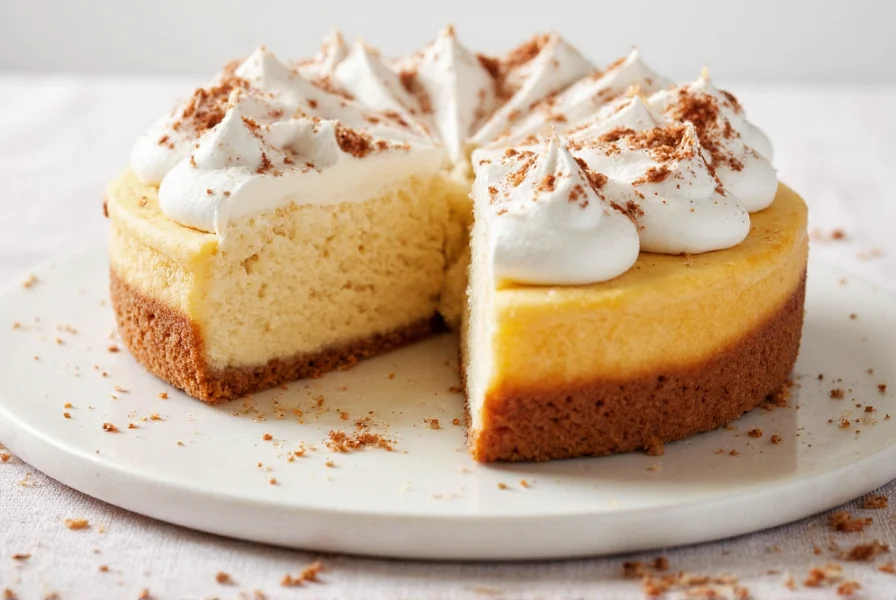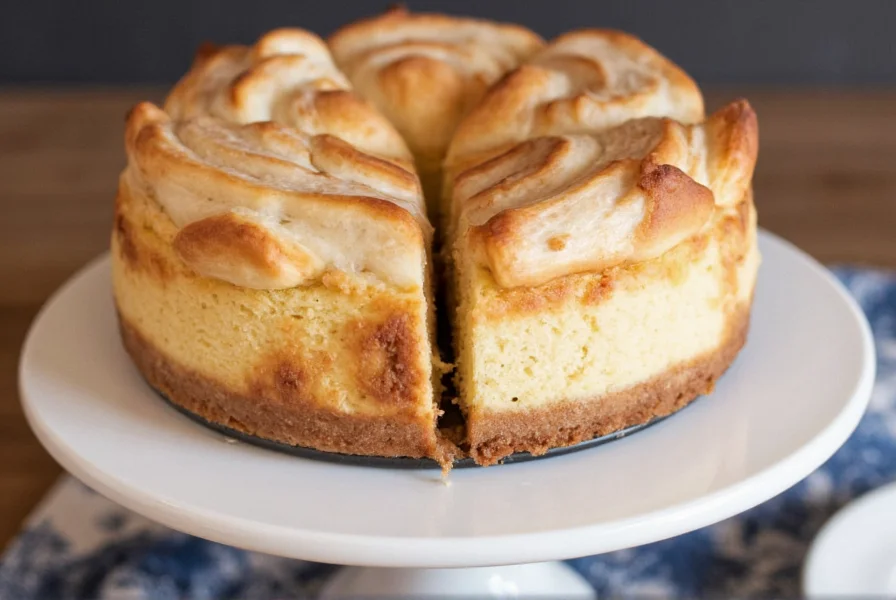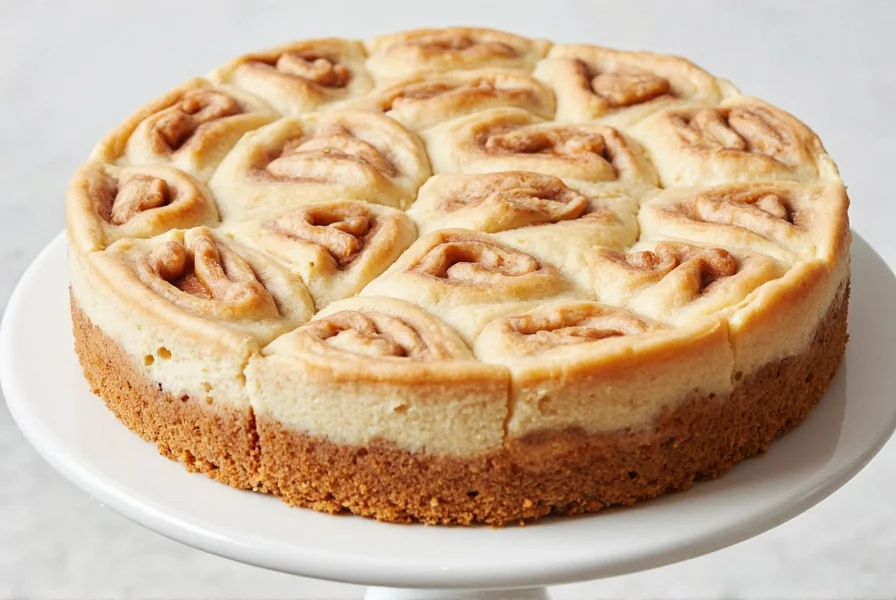Creating the perfect cinnamon roll honeybun cheesecake requires understanding how these three beloved desserts complement each other. Unlike standard cheesecake recipes, this innovative dessert integrates the warm spices of cinnamon rolls with the sticky sweetness of honey buns, resulting in a layered masterpiece that satisfies multiple dessert cravings in one slice.
Understanding the Cinnamon Roll Honeybun Cheesecake Components
This hybrid dessert works because each element serves a specific purpose in the final product. The cheesecake base provides structure and creamy richness, while the cinnamon roll component adds texture and that familiar swirl pattern dessert lovers crave. The honey bun element brings moisture and a distinctive sweet finish that ties everything together.
When properly executed, the cinnamon roll honeybun cheesecake shouldn't feel like three separate desserts awkwardly combined. Instead, the flavors should meld seamlessly, with the cream cheese cutting through the sweetness of the honey and cinnamon, creating balance in every bite.
Essential Ingredients for Success
The magic of this dessert lies in using quality ingredients that complement rather than compete with each other. Here's what you'll need for an authentic cinnamon roll honeybun cheesecake experience:
| Component | Key Ingredients | Why It Matters |
|---|---|---|
| Cheesecake Base | Cream cheese, eggs, sugar, vanilla, sour cream | Creates the rich, smooth foundation that balances the sweetness above |
| Cinnamon Roll Layer | Flour, yeast, butter, cinnamon, brown sugar | Provides the signature swirl and comforting spice notes |
| Honey Glaze | Honey, butter, powdered sugar, cream | Adds sticky sweetness and moisture that defines honey buns |
Step-by-Step Preparation Guide
Follow these detailed instructions for the best cinnamon roll honeybun cheesecake results. This process requires attention to timing as you'll be working with multiple components that need to come together perfectly.
Preparing the Cheesecake Base
- Preheat oven to 325°F (163°C) and prepare a 9-inch springform pan with parchment paper
- Mix 2 cups graham cracker crumbs, 1/4 cup melted butter, 2 tablespoons cinnamon, and 2 tablespoons brown sugar for the spiced crust
- Press firmly into the bottom of the pan and bake for 10 minutes
- Cool while preparing the cheesecake filling
- Beat 32oz cream cheese until smooth, then gradually add 1 cup sugar
- Mix in 3 eggs one at a time, followed by 1 teaspoon vanilla and 1/2 cup sour cream
- Pour over cooled crust and bake for 45-55 minutes until center is almost set
- Cool completely before adding the cinnamon roll layer
Creating the Cinnamon Roll Component
The cinnamon roll layer requires careful timing. You'll want to prepare this when your cheesecake base has cooled but before it's fully set in the refrigerator.
- Prepare a basic cinnamon roll dough (flour, yeast, milk, sugar, butter)
- Roll out to approximately 12x16 inches
- Spread with softened butter, then sprinkle with cinnamon-sugar mixture (1 cup brown sugar + 3 tbsp cinnamon)
- Roll tightly and slice into 12 equal pieces
- Arrange evenly on top of the cooled cheesecake base
- Cover and let rise for 30-45 minutes until puffy
Finishing with Honey Glaze
The honey glaze transforms this from a simple combination to a true honey bun cheesecake experience:
- Bake the assembled dessert at 350°F for 25-30 minutes until cinnamon roll topping is golden
- While baking, prepare glaze: simmer 1/2 cup honey, 2 tbsp butter, and 1/4 cup cream for 5 minutes
- Remove from oven and immediately brush with warm honey glaze
- Cool completely before refrigerating for at least 4 hours
- Before serving, drizzle with additional honey glaze and sprinkle with cinnamon
Critical Baking Tips for Perfect Results
Mastering the cinnamon roll honeybun cheesecake requires attention to specific details that many recipes overlook:
- Temperature control: Ensure all dairy ingredients are at room temperature before mixing to prevent curdling
- Rising time: The cinnamon roll topping needs proper rise time but shouldn't overproof, which would cause collapse during baking
- Baking sequence: The lower temperature for the cheesecake base (325°F) versus the higher temperature for the topping (350°F) is crucial for proper setting
- Glaze timing: Applying the honey glaze immediately after baking allows it to soak into the cinnamon roll layer without making it soggy
- Chilling time: Allow at least 4 hours (preferably overnight) for the cheesecake to set properly before slicing
Avoiding Common Cinnamon Roll Honeybun Cheesecake Mistakes
Even experienced bakers encounter challenges with this complex dessert. Here are frequent issues and how to solve them:
| Problem | Causes | Solution |
|---|---|---|
| Cheesecake cracks | Overbaking, temperature shock, improper mixing | Bake in water bath, cool gradually, use room temperature ingredients |
| Cinnamon roll topping sinks | Cheesecake not fully cooled, topping too heavy | Ensure base is completely cool, don't overfill with topping |
| Soggy bottom layer | Insufficient crust baking, moisture from topping | Pre-bake crust thoroughly, create barrier with thin chocolate layer |
| Glaze doesn't stick | Applied when too cool, wrong consistency | Apply warm glaze immediately after baking, adjust thickness as needed |
Variations and Customizations
Once you've mastered the basic cinnamon roll honeybun cheesecake recipe, try these creative variations:
- Nutty version: Add chopped pecans or walnuts to the cinnamon sugar mixture for extra texture
- Cream cheese swirl: Mix cream cheese with sugar and vanilla, then swirl into the cinnamon roll topping before baking
- Spiced upgrade: Add 1/2 teaspoon each of nutmeg and cardamom to the cinnamon sugar for deeper flavor
- Mini portions: Create individual servings using muffin tins for perfect portion control
- Dairy-free option: Use plant-based cream cheese and butter alternatives for dietary restrictions
Serving and Storage Recommendations
For the best cinnamon roll honeybun cheesecake experience:
- Serve chilled but allow to sit at room temperature for 15-20 minutes before cutting
- Use a hot knife for clean slices (dip in hot water, wipe dry, then cut)
- Store covered in the refrigerator for up to 5 days
- Freeze whole or in slices (wrapped tightly) for up to 2 months
- Thaw frozen slices in the refrigerator overnight before serving

Why This Dessert Combination Works
The cinnamon roll honeybun cheesecake succeeds because it addresses multiple sensory experiences simultaneously. The creamy richness of cheesecake balances the sweet stickiness of the honey bun topping, while the cinnamon provides warmth that ties everything together. Unlike standalone desserts, this fusion creates a more complex flavor profile that evolves with each bite.
Professional bakers note that the key to successful dessert hybrids like this cinnamon roll honeybun cheesecake is maintaining the integrity of each component while creating harmony between them. When executed properly, you should distinctly recognize each element without any one component overwhelming the others.

Final Thoughts on Mastering This Dessert Fusion
The cinnamon roll honeybun cheesecake represents the exciting possibilities when classic desserts are thoughtfully combined. While it requires more effort than standard recipes, the result is a show-stopping dessert that delivers multiple beloved flavors in perfect harmony.
Remember that practice makes perfect with complex desserts like this. Your first attempt at making cinnamon roll honeybun cheesecake might not be flawless, but understanding the purpose of each component will help you troubleshoot and improve with each iteration. The most successful versions balance the creaminess of cheesecake, the spice of cinnamon rolls, and the sweet stickiness of honey buns without letting any single element dominate.
Can I make cinnamon roll honeybun cheesecake without yeast?
Yes, you can create a simplified version using canned cinnamon roll dough as the topping layer. While traditional yeast-raised dough provides the best texture, quality refrigerated cinnamon rolls work well for the honey bun component when time is limited. Just be sure to adjust the baking time slightly as pre-made dough may require less time to cook through.
How do I prevent my cheesecake layer from cracking?
To prevent cracks in your cinnamon roll honeybun cheesecake base, use a water bath when baking the cheesecake layer, ensure all ingredients are at room temperature before mixing, avoid overmixing which incorporates too much air, and allow the cheesecake to cool gradually in the oven with the door slightly ajar. A thin layer of melted chocolate between the crust and cheesecake filling can also create a moisture barrier that helps prevent cracking.
What's the best way to store leftover cinnamon roll honeybun cheesecake?
Store leftover cinnamon roll honeybun cheesecake covered in the refrigerator for up to 5 days. For longer storage, wrap individual slices tightly in plastic wrap and then in aluminum foil before placing in freezer bags. Frozen slices will keep for up to 2 months. Thaw in the refrigerator overnight before serving. Never leave this dessert at room temperature for more than 2 hours due to the dairy content.
Can I make this dessert ahead of time for a special occasion?
Yes, the cinnamon roll honeybun cheesecake is actually better when made 1-2 days in advance. The flavors have time to meld together, and the structure sets more firmly, making for cleaner slices. Prepare the cheesecake base and let it chill completely, add the cinnamon roll topping and bake, then apply the glaze. Once fully cooled, cover and refrigerate. Add a fresh drizzle of warm honey glaze just before serving for the best presentation.
Frequently Asked Questions
- Can I make cinnamon roll honeybun cheesecake without yeast? Yes, you can create a simplified version using canned cinnamon roll dough as the topping layer. While traditional yeast-raised dough provides the best texture, quality refrigerated cinnamon rolls work well for the honey bun component when time is limited.
- How do I prevent my cheesecake layer from cracking? To prevent cracks, use a water bath when baking, ensure all ingredients are room temperature, avoid overmixing, and allow gradual cooling. A thin chocolate layer between crust and filling creates a helpful moisture barrier.
- What's the best way to store leftover cinnamon roll honeybun cheesecake? Store covered in the refrigerator for up to 5 days. For longer storage, wrap individual slices tightly and freeze for up to 2 months. Thaw in the refrigerator overnight before serving.
- Can I make this dessert ahead of time for a special occasion? Yes, this dessert actually improves when made 1-2 days in advance. The flavors meld together and the structure sets more firmly. Prepare completely, then add a fresh drizzle of warm honey glaze just before serving.











 浙公网安备
33010002000092号
浙公网安备
33010002000092号 浙B2-20120091-4
浙B2-20120091-4